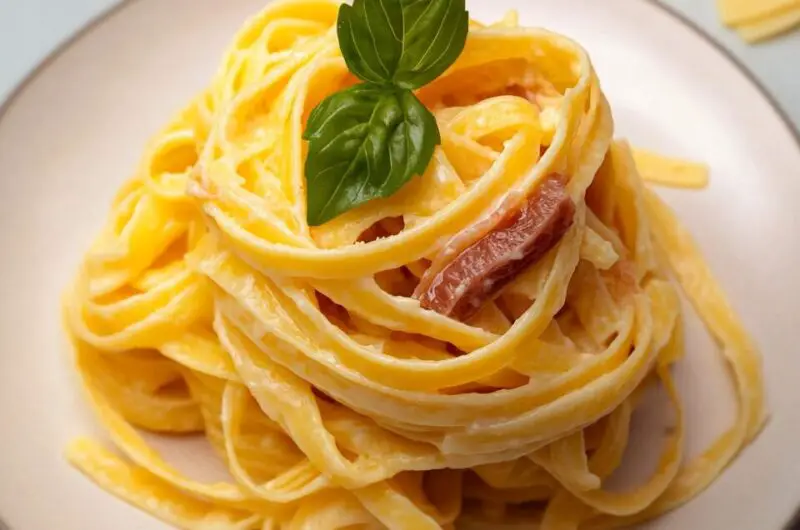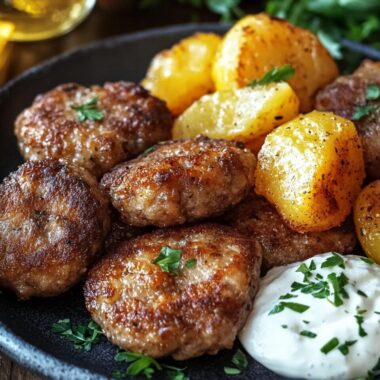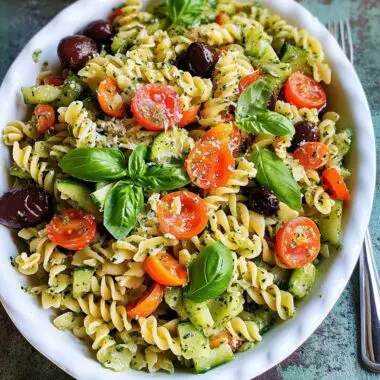Pasta alla Gricia is a beloved Roman dish that showcases the elegance of simplicity. With just a handful of ingredients pasta, crispy guanciale, sharp pecorino romano, and freshly cracked black pepper this dish delivers an explosion of rich, savory flavors. The creamy sauce forms naturally as the cheese melts into the starchy pasta water, enveloping every bite in indulgent silkiness. This dish is often considered the “parent” of Amatriciana, Carbonara, and Cacio e Pepe, making it a foundational recipe in Italian cuisine. Whether enjoyed in a rustic trattoria in Rome or prepared in your own kitchen, Pasta alla Gricia is a timeless dish that proves sometimes, the simplest recipes are the most delicious.
Full Recipe:
Ingredients:
- 11 oz spaghetti or tonnarelli
- 6 oz guanciale (or pancetta)
- 6 oz pecorino romano cheese, finely grated
- 1 tbsp black pepper, freshly ground (medium-coarse)
- ½ cup white wine
Directions:
- Toast the Black Pepper: In a dry pan over low heat, toast the black pepper for about a minute until fragrant. Set aside.
- Fry the Guanciale: Cut the guanciale into ½-inch strips and fry in a dry pan over medium-low heat until the fat turns translucent. Increase heat slightly to crisp up the edges.
- Cook the Pasta: Boil the pasta in salted water, cooking for ¾ of the recommended ‘al dente’ time.
- Deglaze the Pan: Add the white wine to the pan with the guanciale, scraping up any browned bits for added flavor.
- Finish Cooking the Pasta: Transfer the drained pasta to the skillet with the guanciale. Add a few ladles of pasta water and black pepper. Continue cooking until pasta is fully done, adding water as needed.
- Make the Cheese Sauce: Gradually mix a ladle of hot pasta water into the pecorino romano to create a creamy paste.
- Combine and Serve: Remove the pasta from heat. Stir in the cheese sauce, mixing thoroughly. Serve immediately and enjoy!
Prep Time: 15 minutes | Cooking Time: 10 minutes | Total Time: 25 minutes
Kcal: 450 kcal | Servings: 4
The History and Origins of Pasta alla Gricia
While its exact origins are debated, Pasta alla Gricia is believed to have been developed by shepherds in the mountainous areas of Lazio. Before the 18th century, when tomatoes became a staple in Italian cooking, many traditional pasta dishes were made using just cheese, cured meats, and pepper. This explains why Pasta alla Gricia is often referred to as the precursor to Amatriciana, which later incorporated tomatoes.
The name “Gricia” is thought to come from the town of Grisciano, a small village near Amatrice. This region is famous for its hearty, rustic dishes that rely on simple ingredients. Another theory suggests that the name derives from the Roman dialect term “gricio,” which was used to describe bakers and food merchants who supplied essential goods like flour, cheese, and cured meats. Regardless of its exact origins, what remains undisputed is Pasta alla Gricia’s place in Roman culinary tradition.
Why Guanciale is Essential
One of the defining ingredients in Pasta alla Gricia is guanciale, a cured meat made from pork cheek. Unlike pancetta (which comes from pork belly), guanciale has a richer, more intense flavor due to its higher fat content and curing process. When rendered in a pan, guanciale releases its flavorful fat, creating a luscious base for the sauce that coats the pasta beautifully.
While some modern adaptations use pancetta as a substitute, true Roman Pasta alla Gricia must be made with guanciale. The meat’s natural depth and umami flavor are what give the dish its signature taste. If guanciale is unavailable, pancetta can be used in a pinch, but the experience won’t be quite the same.
The Role of Pecorino Romano
Another key component is Pecorino Romano cheese, a hard, salty cheese made from sheep’s milk. It has been produced in Italy for over 2,000 years and was once a staple in the diets of Roman soldiers. Its bold, tangy flavor pairs perfectly with the richness of the guanciale, balancing the dish and adding a creamy texture when melted into the pasta.
Pecorino Romano differs significantly from Parmigiano-Reggiano, which is made from cow’s milk and has a milder, nuttier taste. The sharpness of Pecorino Romano enhances the overall depth of Pasta alla Gricia, making it a crucial ingredient that should not be substituted.
The Art of Achieving the Perfect Creamy Sauce
One of the secrets to mastering Pasta alla Gricia is creating the perfect sauce without the use of cream or butter. The creaminess comes from the combination of rendered guanciale fat, pasta starch, and finely grated Pecorino Romano.
To avoid clumps and ensure a smooth texture, the cheese should be mixed with a small amount of hot pasta water before being added to the dish. This technique, known as mantecatura, helps create a silky, emulsified sauce that clings to the pasta perfectly. It’s important to add the cheese off the heat to prevent it from coagulating too quickly, which can lead to a gritty texture.
The Best Pasta for Pasta alla Gricia
Traditionally, spaghetti or tonnarelli (a square-shaped spaghetti) are used for Pasta alla Gricia. However, rigatoni is another popular choice, as its ridges help trap the rich sauce and bits of crispy guanciale. The pasta should always be cooked until just under al dente, as it will finish cooking in the sauce, absorbing all the delicious flavors.
The use of high-quality pasta made from durum wheat semolina is essential. Italian pasta has a firmer texture compared to many mass-produced varieties, which ensures it holds up well when combined with the sauce.
Pairing Pasta alla Gricia with Wine
When it comes to wine pairings, Pasta alla Gricia pairs wonderfully with Italian white wines that have bright acidity and mineral notes. Some excellent options include:
- Frascati Superiore – A crisp white wine from Lazio that complements the saltiness of the pecorino.
- Verdicchio dei Castelli di Jesi – A structured, slightly nutty white wine with fresh acidity.
- Trebbiano d’Abruzzo – A light, citrusy wine that balances the richness of the guanciale.
For red wine lovers, a light-bodied red with good acidity, such as a Chianti Classico or a Montepulciano d’Abruzzo, can also work well. These wines have enough structure to stand up to the dish’s bold flavors without overpowering them.
How Pasta alla Gricia Fits into Roman Cuisine
Pasta alla Gricia is one of the four essential Roman pasta dishes, alongside Cacio e Pepe, Carbonara, and Amatriciana. These dishes all share a common foundation of Pecorino Romano and black pepper, but each adds its own distinct elements.
- Cacio e Pepe: The simplest of the four, made with only Pecorino Romano, black pepper, and pasta water.
- Carbonara: Adds eggs to create a creamy sauce, along with guanciale.
- Amatriciana: Includes tomatoes, giving the dish a rich, slightly sweet flavor.
Pasta alla Gricia serves as the historical link between these dishes, maintaining the purity of its ingredients while setting the stage for the evolution of Roman pasta recipes.
Conclusion:
Pasta alla Gricia is a must-try for anyone who loves Italian cuisine. It is a dish that exemplifies simplicity, tradition, and the power of high-quality ingredients. With just four main components pasta, guanciale, Pecorino Romano, and black pepper it delivers an incredible depth of flavor that rivals even the most complex dishes.
Whether you’re recreating it at home or enjoying it in a Roman trattoria, Pasta alla Gricia is a true taste of Italy’s rich culinary history. Its perfect balance of salty, savory, and creamy elements makes it an unforgettable meal that deserves a place in any pasta lover’s repertoire.








